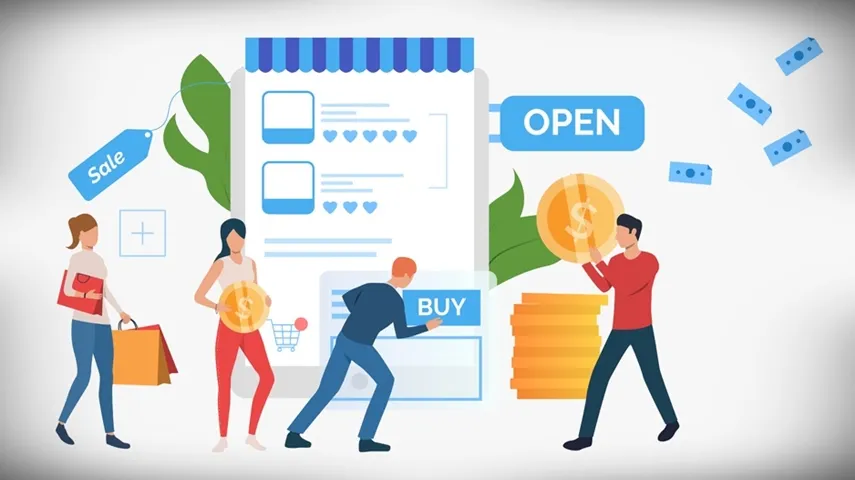E-Commerce Business
Are you ready to supercharge your e-commerce business and leave your competition in the dust?
Growth hacking focuses on rapid experimentation and data-driven decision-making combined, which can be the secret weapon for many online retailers. In this guide, we’ll explore real growth hacking strategies for e-commerce businesses that online stores use and how they can supercharge their sales and customer base.
We will cover everything from using the power of content marketing to tapping into user-generated content. So, get ready to transform your online store into a growth machine!
Content Marketing: Your Gateway to E-Commerce Success
Growth hacking for e-commerce is about attracting and retaining customers while minimizing costs. One of the most effective strategies is content marketing.
By creating valuable, informative, and entertaining content, you could attract potential customers and establish your brand as authoritative in your niche. This would not only drive organic traffic but also build trust over time.
For example, you might use a content upgrade where a pop-up window offers a free report in exchange for the visitor’s email. This approach is much more effective at generating leads than other methods.
Many marketers have reported multi-fold increases in the number of email subscribers and revenue.
Influencer Marketing: Leveraging Social Proof and Credibility
One more major growth hacking strategy is the use of influencer marketing. It consists of collaborating with influencers from your area of specialization who already have a following.
They can instantly give you credibility in the marketplace. This is especially beneficial to the owners of e-commerce businesses because influencers can represent products in very convincing and appealing formats.
When screening influencers, try to engage those whose followers correspond to your target customers. And remember, it doesn’t mean followers always translate to sales.
Many micro-influencers with smaller but highly active follower bases positively outperform the more significant influencers with less active fans.
A/B Testing: The Science of Continuous Optimization
A-B testing assists with activities such as growth hacking and is highly important for commerce deals.
By recording product descriptions, images, checkout, and pricing, you can properly test the varied parts of your website, gauge whether your audience will be interested in it, and convert accordingly.
It is recommended that you do not limit A/B testing only to websites. Incorporate email marketing, social media, and even product A/B testing.
The most important thing here is that the A/B testing is rigorous and based on properly recorded data, which will give us valuable insights.
Visual Storytelling: Capturing Customer Imagination
The evolution of growth hacking has made a lot of people miss some beneficial strategies, such as creative photo stories. Imagery is key in e-commerce; hence, creative imagery will always make wonders.
Try telling photo stories of your products, a brand story, or a customer story. These types of pictures can be used all over the internet, from different social media to websites, and this increases engagement and conversions significantly.
Remember to tweak the images to fit the multiple platforms that will be used and to adhere to the brand identity.
Loyalty and Referral Programs: Turning Customers into Brand Ambassadors
Loyalty schemes are undoubtedly one of the most effective ways to keep customers and encourage them to buy again. However, if you truly want to hack growth, you ought to try a referral scheme in addition to your loyalty program.
This approach benefits your existing clients and enables you to tap into their circles to acquire new clients. Structure your referral program so that both the referrer and the new client derive substantial value from it.
This method of designing referral programs can be very effective, as happy clients become brand advocates and do the marketing for you, resulting in many new clients.
Innovative Pricing Strategies: WooCommerce Name Your Price
One unconventional growth strategy that works very well in the context of e-commerce is using the WooCommerce Name Your Price plugin.
This type of tool lets customers pick a price of the products they want to sell, and that can be really good for some amount of charity, some market test, or some goods to increase the hype.
Allowing a more profound price control may prevent valuable data from walking away unexamined. This technique may help boost sales volume.
Perhaps it will also make it easier to gain a larger target audience because the products will be available for almost all budgets.
Personalization: The Key to Customer Conversion
A key asset of a growth hacker focused on e-commerce is personalization. Use users’ browsing and buying information to generate product recommendations and automated email marketing campaigns.
This model both improves clients’ experiences and increases the possibility of conversion. You might want to consider using AI-based recommendation systems that can accurately predict what customers would like based on their history.
Always strive for maximum offering relevancy, as this increases the chances of making a sale.
User-Generated Content: Building Trust and Community
Another smart move in an e-commerce business growth hacking strategy is the use of user-generated content (UGC).
Customers can be asked to record short clips or take pictures of themselves using the products and share them, write reviews, or join branded hashtag contests. This helps build bonds between customers and the company or its products, in addition to providing social proof.
UGC can easily be reused across different marketing platforms, from the website to social networks, emails, and even pay-per-click advertisements. This approach cuts down on content creation expenses, increases engagement, and boosts potential customers’ trust.
Website Performance: Speed Equals Success
In e-commerce, speed kills. Even a single-second delay can wreak havoc on your conversion rates and even eliminate sales opportunities you would never wish to experience.
That said, utilizing advanced methods such as image optimization, browser caching, content delivery networks (CDNs), and even mobile page acceleration (AMP) can help improve your overall site speed and mobile browsing experience, which in turn can greatly reduce your bounce rates.
After all, in this world of self-imposed limitations, every second does count.
Recapturing Lost Opportunities: Exit-Intent and Abandoned Cart Strategies
On a closing note, do not forget the benefit that exit intent pops up, as well as the cart abandonment notifications offered. These tools ensure you recapture visitors who are just about to leave your site or have left items in their carts that benefit you.
Custom-tailor your offers or reminders to motivate visitors to complete their purchases. Follow-up emails with increasing rewards and recovery strategies, as well as setting up summer sales offers, can encourage people to complete their transactional journey.
In doing so, you might be able to recover a significant number of lost sales and increase your conversion rates tremendously.
Conclusion
Growth hacking revolves around creativity as well as data analysis and rapid experimentation to foster explosive growth in your e-commerce business.
So, whether through content marketing, influencer marketing, or more innovative strategies such as personalized pricing, they all serve as legitimate shortcuts for e-commerce success. And do not forget about continuous testing and optimization, which is the most effective growth hacking strategy.
Stay open to new ideas, adopt a new approach, analyze the outcome, and adjust to the data, whatever it tells you.
Settling for mediocrity is simply not an option because, without the right approach and determination, your e-commerce business will not be able to transform into a growth powerhouse that achieves remarkable success.




